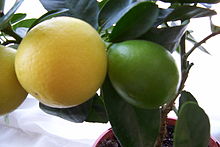- Limequat
-
Limequat 
A Eustis Limequat Scientific classification 
Kingdom: Plantae clade: Angiosperms clade: Eudicots clade: Rosids Order: Sapindales Family: Rutaceae Genus: Citrus Species: C. × floridana Binomial name Citrus × floridana
(J. Ingram & H. Moore) Mabb.The limequat is a citrus tree that is the result of a cross between the Key lime and the kumquat, hybridized by Dr. Walter Swingle in 1909.[1]
Contents
Description
It is a small tree that grows into a contained bushy form. The leaves are characteristically citrus-like. The limequat produces an abundance of fruit even at a young age. The fruit is small, oval, greenish yellow and contains seeds or pips. It has a sweet tasting skin and a bitter sweet pulp that tastes similar to limes. The fruit can be eaten whole or the juice and rind can be used to flavor drinks and dishes. It has considerable amounts of vitamin C and is strongly acidic.
This plant is now grown in Japan, Israel, Spain, Malaysia, South Africa, Armenia, the United Kingdom and the United States in California, Florida, and Texas. The fruit can be found, in small quantities, during the fall and winter months in the United States.
Varieties
There are three different named cultivars of limequats:
- Eustis (Citrus japonica × Citrus aurantiifolia) - Key lime crossed with round kumquat, the most common limequat. It was named after the city of Eustis, Florida.
- Lakeland (Citrus japonica × Citrus aurantiifolia) - Key lime crossed with round kumquat, different seed from same hybrid parent as Eustis. Fruit is slightly larger and contains a few fewer seeds than Eustis. It was named after the city of Lakeland, Florida.
- Tavares (Citrus japonica 'Margarita' × Citrus aurantiifolia) - Key lime crossed with oval kumquat (though there is some speculation that it is actually a lemon/kumquat hybrid), fruit is larger and more elongated and color at maturity is more orange than other limequats. It was named after the city of Tavares, Florida.[1]
Care
Limequats can be grown indoors or outdoors providing the temperature stays between 10°C to 30°C (50°F to 86°F). They are fairly small and can be planted in containers or pots. Plant limequats in a well drained fertile soil. Incorporate a good compost with some gravel or other drainage-aiding substance. Sand, despite popular opinion, is poor for aiding drainage. Adding mulch or compost on top of the soil can be very beneficial. Plant anytime of the year, watering it well. Water when nearly dry and add fertilizer occasionally. It can be pruned to keep a shape.
Plants grow fairly slowly and flower and fruit between 5–7 months and rest for 7–5 months.
Limequats are more cold-hardy than limes but less cold-hardy than kumquats.
References
Categories:- Citrus
- Hybrid plants
- Hybrid Citrus
Wikimedia Foundation. 2010.

